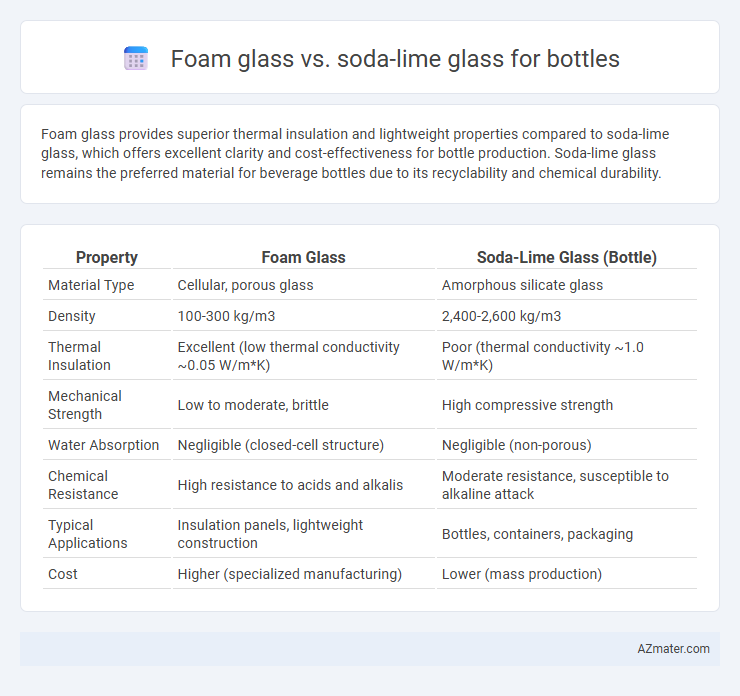Foam glass provides superior thermal insulation and lightweight properties compared to soda-lime glass, which offers excellent clarity and cost-effectiveness for bottle production. Soda-lime glass remains the preferred material for beverage bottles due to its recyclability and chemical durability.
Table of Comparison
| Property | Foam Glass | Soda-Lime Glass (Bottle) |
|---|---|---|
| Material Type | Cellular, porous glass | Amorphous silicate glass |
| Density | 100-300 kg/m3 | 2,400-2,600 kg/m3 |
| Thermal Insulation | Excellent (low thermal conductivity ~0.05 W/m*K) | Poor (thermal conductivity ~1.0 W/m*K) |
| Mechanical Strength | Low to moderate, brittle | High compressive strength |
| Water Absorption | Negligible (closed-cell structure) | Negligible (non-porous) |
| Chemical Resistance | High resistance to acids and alkalis | Moderate resistance, susceptible to alkaline attack |
| Typical Applications | Insulation panels, lightweight construction | Bottles, containers, packaging |
| Cost | Higher (specialized manufacturing) | Lower (mass production) |
Introduction to Foam Glass and Soda-Lime Glass
Foam glass is a lightweight, porous material made from crushed glass that is melted and infused with gas bubbles to create insulation properties, commonly used for thermal and acoustic insulation. Soda-lime glass, the most common type of glass used for bottles, consists primarily of silica, soda ash, and lime, providing durability, clarity, and inexpensive manufacturing. Foam glass is rarely used for bottles due to its fragility and insulation focus, while soda-lime glass dominates the bottle industry for beverages and packaging.
Chemical Composition Differences
Foam glass primarily consists of silica (SiO2), sodium oxide (Na2O), and calcium oxide (CaO), with added foaming agents like carbon or carbonates that produce a cellular structure, enhancing its insulation properties. Soda-lime glass mainly contains approximately 70-74% silica, 12-16% sodium oxide, and 5-12% calcium oxide, without any foaming agents, resulting in a dense, transparent material ideal for bottle manufacturing. The key chemical difference lies in foam glass's incorporation of foaming additives that alter its microstructure and functionality compared to the homogeneous composition of soda-lime glass.
Manufacturing Processes Compared
Foam glass is produced by mixing glass powders with foaming agents followed by controlled heating, which causes gas evolution and creates a porous structure ideal for insulation applications. Soda-lime glass, commonly used in bottle manufacturing, is made by melting silica sand, soda ash, and lime at high temperatures, resulting in a dense, transparent material with excellent formability. The manufacturing process of foam glass is more complex due to the foaming step and lower density requirements, while soda-lime glass benefits from a well-established, continuous melting and forming process optimized for mass bottle production.
Physical and Mechanical Properties
Foam glass exhibits significantly lower density and thermal conductivity compared to soda-lime glass, making it ideal for insulation applications but less suitable for structural purposes. Soda-lime glass offers higher mechanical strength and rigidity, with greater resistance to impact and abrasion, ensuring durability for bottle manufacturing. The cellular structure of foam glass reduces weight and enhances thermal insulation, whereas soda-lime glass provides superior toughness and clarity essential for packaging and containment.
Thermal and Insulation Characteristics
Foam glass offers superior thermal insulation compared to soda-lime glass due to its cellular structure, which traps air and reduces heat transfer, making it ideal for temperature-sensitive storage. Soda-lime glass, commonly used in bottles, has lower thermal insulation and higher thermal conductivity, resulting in less efficient temperature retention. The enhanced insulation properties of foam glass also contribute to better energy efficiency and protection against condensation in packaging applications.
Environmental Impact and Sustainability
Foam glass, made from recycled glass and characterized by its lightweight, porous structure, offers superior insulation and significantly reduces energy consumption during manufacturing compared to soda-lime glass, which is the most common type of glass used in bottles but requires higher temperatures and more raw materials. Foam glass production promotes sustainability by repurposing waste materials and lowering carbon emissions, whereas soda-lime glass contributes more substantially to environmental degradation due to intensive extraction and processing of silica, soda ash, and lime. Choosing foam glass for bottles enhances circular economy efforts by minimizing landfill waste and reducing the overall ecological footprint of glass packaging.
Cost Analysis and Economic Considerations
Foam glass offers superior thermal insulation and durability but comes with higher initial production costs compared to soda-lime glass, which is the industry standard for bottles due to its low manufacturing expenses and abundant raw materials. Soda-lime glass benefits from economies of scale, making it more cost-effective for mass production despite lower performance in insulation and fracture resistance. Economic considerations favor soda-lime glass for large-scale bottling operations aiming to minimize costs, while foam glass may be justified in niche markets prioritizing energy efficiency and product protection.
Performance in Bottle Applications
Foam glass offers superior thermal insulation and shock resistance compared to soda-lime glass, making it ideal for maintaining temperature-sensitive contents in bottles. Its closed-cell structure provides outstanding durability and lightweight properties, enhancing bottle performance under mechanical stress. Soda-lime glass, while cost-effective and widely used, lacks the enhanced insulating and impact resistance qualities essential for specialized bottle applications.
Recyclability and End-of-Life Options
Foam glass and soda-lime glass differ significantly in recyclability and end-of-life options. Soda-lime glass, widely accepted in curbside recycling programs, can be recycled indefinitely without loss of quality, reducing landfill waste significantly. Foam glass, while offering excellent insulation and durability, is less commonly recycled due to its specialized structure and is often downcycled or repurposed as aggregate material after use.
Industry Trends and Future Prospects
Foam glass offers superior thermal insulation and lightweight properties compared to traditional soda-lime glass, making it increasingly favored in sustainable packaging trends within the bottle industry. The shift towards eco-friendly materials and energy-efficient manufacturing processes drives demand for foam glass, as it supports circular economy initiatives through recyclability and lower carbon footprints. Advances in foam glass technology and scaling production are anticipated to expand its application in bottle manufacturing, challenging soda-lime glass's dominance due to enhanced performance and environmental benefits.

Infographic: Foam glass vs Soda-lime glass for Bottle
 azmater.com
azmater.com